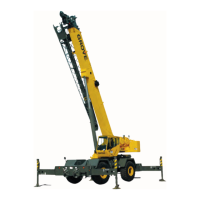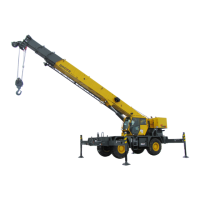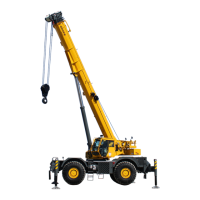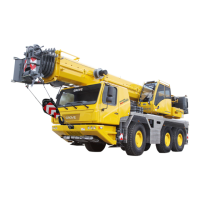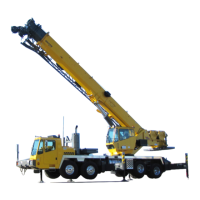GROVE 7-25
CD3340B/YB4411 TRANSMISSION AND TORQUE CONVERTER
Published 04/07/2015 Control # 569-00
In the example shown, the engine speed is abnormally high
when 2
nd gear forward is selected indicating a slipping clutch.
From the example, it is evident that the layshaft clutch is
working normally (2
nd gear reverse indicates 1985 rpm).
Therefore, it follows that the suspect clutch is the forward
high. Assuming all other possible faults have been
eliminated (see Troubleshooting), this clutch should be
serviced.
Example Only:
Pressure and Flow Tests
Before completing any transmission pressure/flow tests,
make sure that the oil level is correct and is at normal
operating temperature.
Pump Flow
NOTE: Special adapters are required to perform the
following test. Contact your distributor. See
Figure 7-13.
1. Stop the engine, remove the filter F and filter head
adapter from the transmission. Install a special test
adapter X onto the threaded spigot. Install special test
adapter Y and secure with adapter Z. Connect a
flowmeter W.
2. Start the engine and run at 1000 rpm. With the
transmission in neutral, the flowmeter will show the
pump flow. Compare this reading with the pump flow
specifications. A low reading indicates a worn pump or
blocked suction strainer.
3. Repeat step 2 and note the gauge reading with the
engine running at 2000 rpm. Indicates same fault as in
step 2.
4. Stop the engine and remove all test adapters. Install the
filter.
Mainline Pressure
See Figure 7-13.
1. Stop the engine and connect a 0-20 bar (0-300 psi)
pressure gauge to the test connector A.
2. Start the engine and run at 1000 rpm. With the
transmission in neutral the pressure gauge will show the
mainline pressure. Compare this pressure reading with
the one listed on page 7-2. Either a faulty pressure
maintenance valve or a worn pump can cause a low
reading. A high reading may indicate a faulty pressure
maintenance valve.
3. Repeat step 2 and note gauge reading with engine
running at 2000 rpm. Indicates same fault as in step 2.
4. Stop the engine and remove the test gauge.
Converter Out Pressure/Oil Cooler Flow Rate
See Figure 7-13.
1. Stop the engine and connect a 0-20 bar (0-300 psi)
pressure gauge and flow meter into the converter out
line as shown at C and K respectively.
2. Run the engine at 1000 rpm with the transmission in
neutral. The pressure gauge indicates the converter out
pressure and the flow meter indicates the oil cooler flow
rate. Compare both readings with the specifications on
page 7-2. A blocked oil cooler could cause a high
pressure together with a low flow.
3. Repeat step 2 and note the gauge reading with engine
running at 2000 rpm. Same fault as indicated in step 2.
4. Stop the engine, remove the test gauge and flow meter
and install hoses to original position.
Gear
Selected
Ratio Clutch
Mainshaft
or
Layshaft
Clutch
RPM
Second
Third
Second
Third
Forward High
Forward Low
Reverse High
Reverse Low
Layshaft
Mainshaft
Layshaft
Mainshaft
2060
1990
1985
1980
WARNING
Fine jets of hydraulic oil at high pressure can penetrate
the skin. Do not use your hand to check for hydraulic
leaks. Do not put your face close to suspected leaks. Hold
a piece of cardboard close to suspected leaks and inspect
the cardboard for signs of hydraulic oil. If hydraulic oil
penetrates your skin, get medical help immediately.
WARNING
Take care when disconnecting hydraulic hoses and
fittings. The oil will be hot and could cause burns.
WARNING
DO NOT go under the crane with the engine running. Turn
the engine off, apply the parking brake and remove the
ignition key before going underneath the machine.
Reference Only
